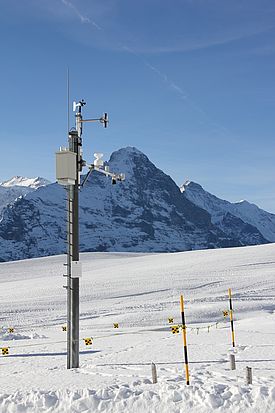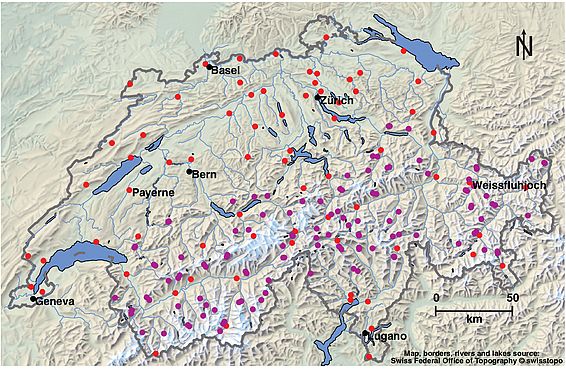Scientists from the WSL Institute for Snow and Avalanche Research (SLF) and the Swiss Federal Institute of Technology Lausanne (EPFL) have developed a method to improve the temporal resolution of climate change scenarios, enabling them to downscale time series for key climate variables from daily to hourly resolution. They have also extended the data sets to measuring stations in the Intercantonal Measurement and Information System (IMIS). Consequently, the network of stations in the Swiss alpine regions for which scenarios are available is now significantly denser.
Climate change scenarios provide an important basis for assessing the impact of climate change in various fields. For example, forecasts of Switzerland's future water balance or changes in the frequency and severity of natural hazard events can be derived from these scenarios. Until now, the most up-to-date climate change scenarios for Switzerland, known as the CH2018 scenarios, have only provided daily mean values. However, for more precise modelling, intra-day developments are often also important.
Higher temporal resolution ¶
In view of this, researchers from the SLF and EPFL have recently published a set of new climate change scenarios at hourly resolution. This entailed "downscaling" the CH2018 daily values to hourly values using an approach known as delta change. With this method, which the scientists first had to refine, the daily-resolution seasonal signal of the climate change scenario for a station is overlaid with the past hourly values measured at the same station, resulting in data sets that simultaneously reflect the seasonal signal of the climate change scenario for the future and the typical daily variation for the station based on the historical measurements. In this way, the researchers generated time series for all decades between 1990 and 2100 for the key climate parameters of temperature, precipitation, humidity, wind speed and shortwave radiation. The data sets are available for 68 CH2018 scenarios, which are based on different assumptions about future developments.
Spatial downscaling ¶
The temporal refinement was initially calculated for 72 MeteoSwiss stations for which CH2018 scenarios are available. The researchers then also extended the time series to 116 IMIS stations. These are automated measuring stations in high alpine regions, operated by the relevant cantons and the SLF. As a result, the network of stations in the Swiss alpine regions for which climate change scenarios are available is now significantly denser.
Freely available data ¶
The authors of the study point out that, due to the methodology used, the new scenarios are only of limited use in predicting extreme events and the frequency of precipitation. Nevertheless, the new high-resolution climate change scenarios form an important basis for further studies. The data will be used, among other things, in two research programmes, Hydro-CH2018 and Climate Change Impacts on Alpine Mass Movements (CCAMM), to predict the effects of climate change in Switzerland, especially in the alpine regions. The new climate change scenarios and the underlying program code are freely available to all researchers.
Contact ¶
Links ¶
Copyright ¶
WSL and SLF provide the artwork for imaging of press articles relating to this media release for free. Transferring and saving the images in image databases and saving of images by third parties is not allowed.

